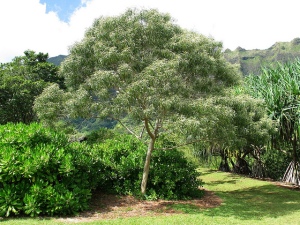
Hawaii has many biomes where plants can grow, this dry land tree has furry long leaves.
Picture from: http://commons.wikimedia.org/wiki/File:Starr_020124-0067_Acacia_koaia.jpg
The Acicia koaia tree, or the native Koai’a tree, is one of Hawaii’s special and unusual dry-land trees, which grows in a low elevation, and open woodland habitats (“Acacia Koai’a”). As a member of the Fabaceae or legume family, it is close cousin to the very well-known koa tree of Hawaii, though have their distinct differences. The koai’a tree is characterized by a short growth height of 5 meters (16ft), which is rather small for a relative of the Koa. Its shortness comes along with its broad and gnarled shape. Its leaves are sickle-shaped described as phyllodes – flat, lengthened petioles that replace leaf blades. The flowers are yellow-cream colored “puff-balls” of corollas with long curled stamens (“Acacia Koaia”).
This tree is able to be pollinated by insects, it can also take advantage of the wind to spread its pollen.
This tree holds a long history with the ancient Hawaiians as well, ranging from tool building to medicinal purposes. Another characterizing feature that separates the koai’a tree from the koa tree is the strength of its wood: koai’a’s is stronger! Since the reddish-brown finely grained wood of the koai’a tree was stronger it was used to make short spears (ihe), long spears (pololū), fish lures (lāʻau melomelo), shark hooks (makau manō), bait sticks in fishing, paddles (hoe), and in house construction by the early Hawaiians. Its flowers were even used in lei making because of its fragrant smell. As a medicine, the koai’a’s leaves were crushed and steamed in bathes to alleviate skin problems (Acacia Koaia).
Dangers:
Its small population size and limited range of growth in dry areas make it very prone to endangerment. Before the arrival of cattle and ungulates, many Koai’a trees used to be in great populations. But the ungulate’s grazing patterns have destroyed most of its numbers. Agriculture and fires could also severely damage the number of individuals left in the population (“Acacia Koaia”).
Fortunately this tree is on its way to recovery: The Koai’a tree is one of the species being used to rejuvinate the vegetation on Kaho’olawe after ordinance testing from the U.S. military, and got overgrazing (Enomoto). There is still work to be done, and areas to be researched and observed, but this tree is back on track and almost out of the endangered zone.

The Koai’a tree is fairly short at its maximum height but has very dense and strong wood
Picture from: https://www.flickr.com/photos/dweickhoff/5187962830/
Source:
“Acacia koaia”. CPC National Collection Plant Profiles. Center for Plant Conservation. 2008-07-22
Enomoto, Kekoa Catherine (2008-02-17). “Volunteers visit regreened Kahoolawe”. The Maui News. Archived from the original on 25 March 2009
” Acacia Koaia.” Native Plants Hawaii. University of Hawaii, 2009. Web. 01 May 2014.
